It might be the world's biggest ocean, but the mighty Pacific is in peril
- Written by Jodie L. Rummer, Associate Professor & Principal Research Fellow, James Cook University
The Pacific Ocean is the deepest, largest ocean on Earth, covering about a third of the globe’s surface. An ocean that vast may seem invincible. Yet across its reach – from Antarctica in the south to the Arctic in the north, and from Asia to Australia to the Americas – the Pacific Ocean’s delicate ecology is under threat.
In most cases, human activity is to blame. We have systematically pillaged the Pacific of fish. We have used it as a rubbish tip – garbage has been found even in the deepest point on Earth, in the Mariana Trench 11,000 metres below sea level.
And as we pump carbon dioxide into the atmosphere, the Pacific, like other oceans, is becoming more acidic. It means fish are losing their sense of sight and smell, and sea organisms are struggling to build their shells.
Oceans produce most of the oxygen we breathe. They regulate the weather, provide food, and give an income to millions of people. They are places of fun and recreation, solace and spiritual connection. So, healthy, vibrant oceans benefit us all. And by better understanding the threats to the precious Pacific, we can start the long road to protecting it.
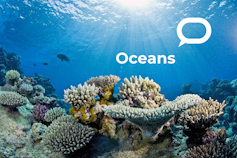 This story is part of Oceans 21
Five profiles open our series on the global ocean, delving into ancient Indian Ocean trade networks, Pacific plastic pollution, Arctic light and life, Atlantic fisheries and the Southern Ocean’s impact on global climate. All brought to you from The Conversation’s international network.
The ocean plastic scourge
The problem of ocean plastic was scientifically recognised in the 1960s after two scientists saw albatross carcasses littering the beaches of the northwest Hawaiian Islands in the northern Pacific. Almost three in four albatross chicks, who died before they could fledge, had plastic in their stomachs.
Now, plastic debris is found in all major marine habitats around the world, in sizes ranging from nanometers to meters. A small portion of this accumulates into giant floating “garbage patches”, and the Pacific Ocean is famously home to the largest of them all.
Most plastic debris from land is transported into the ocean through rivers. Just 20 rivers contribute two-thirds of the global plastic input into the sea, and ten of these discharge into the northern Pacific Ocean. Each year, for example, the Yangtze River in China – which flows through Shanghai – sends about 1.5 million metric tonnes of debris into the Pacific’s Yellow Sea.
This story is part of Oceans 21
Five profiles open our series on the global ocean, delving into ancient Indian Ocean trade networks, Pacific plastic pollution, Arctic light and life, Atlantic fisheries and the Southern Ocean’s impact on global climate. All brought to you from The Conversation’s international network.
The ocean plastic scourge
The problem of ocean plastic was scientifically recognised in the 1960s after two scientists saw albatross carcasses littering the beaches of the northwest Hawaiian Islands in the northern Pacific. Almost three in four albatross chicks, who died before they could fledge, had plastic in their stomachs.
Now, plastic debris is found in all major marine habitats around the world, in sizes ranging from nanometers to meters. A small portion of this accumulates into giant floating “garbage patches”, and the Pacific Ocean is famously home to the largest of them all.
Most plastic debris from land is transported into the ocean through rivers. Just 20 rivers contribute two-thirds of the global plastic input into the sea, and ten of these discharge into the northern Pacific Ocean. Each year, for example, the Yangtze River in China – which flows through Shanghai – sends about 1.5 million metric tonnes of debris into the Pacific’s Yellow Sea.
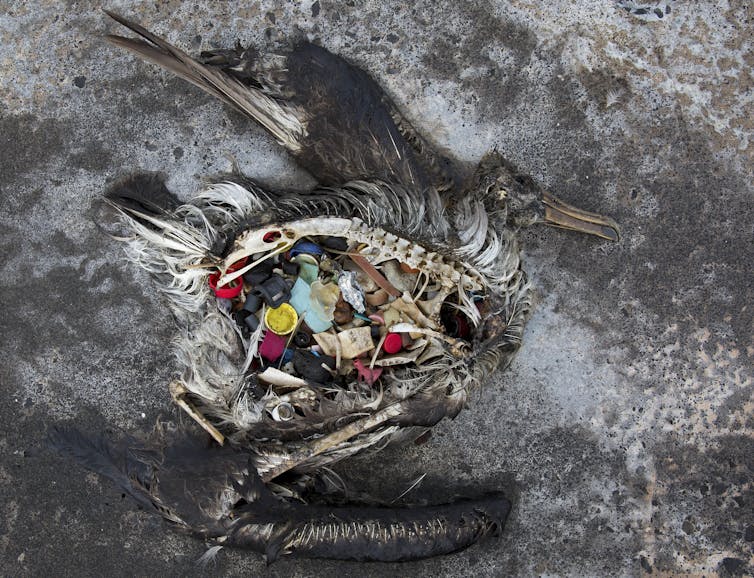 This 2014 photo shows a black footed albatross chick with plastics in its stomach on Midway Atoll in the northwestern Hawaiian Islands.
Dan Clark/ U.S. Fish and Wildlife Service via AP
A wildlife killer
Plastic debris in the oceans presents innumerable hazards for marine life. Animals can get tangled in debris such as discarded fishing nets, causing them to be injured or drown.
Some organisms, such as microscopic algae and invertebrates, can also hitch a ride on floating debris, travelling large distances across the oceans. This means they can be dispersed out of their natural range, and can colonise other regions as invasive species.
Read more:
For decades, scientists puzzled over the plastic 'missing' from our oceans – but now it's been found
And of course, wildlife can be badly harmed by ingesting debris, such as microplastics less than five millimetres in size. This plastic can obstruct an animal’s mouth or accumulate in its stomach. Often, the animal dies a slow, painful death.
Seabirds, in particular, often mistake floating plastics for food. A 2019 study found there was a 20% chance seabirds would die after ingesting a single item, rising to 100% after consuming 93 items.
This 2014 photo shows a black footed albatross chick with plastics in its stomach on Midway Atoll in the northwestern Hawaiian Islands.
Dan Clark/ U.S. Fish and Wildlife Service via AP
A wildlife killer
Plastic debris in the oceans presents innumerable hazards for marine life. Animals can get tangled in debris such as discarded fishing nets, causing them to be injured or drown.
Some organisms, such as microscopic algae and invertebrates, can also hitch a ride on floating debris, travelling large distances across the oceans. This means they can be dispersed out of their natural range, and can colonise other regions as invasive species.
Read more:
For decades, scientists puzzled over the plastic 'missing' from our oceans – but now it's been found
And of course, wildlife can be badly harmed by ingesting debris, such as microplastics less than five millimetres in size. This plastic can obstruct an animal’s mouth or accumulate in its stomach. Often, the animal dies a slow, painful death.
Seabirds, in particular, often mistake floating plastics for food. A 2019 study found there was a 20% chance seabirds would die after ingesting a single item, rising to 100% after consuming 93 items.
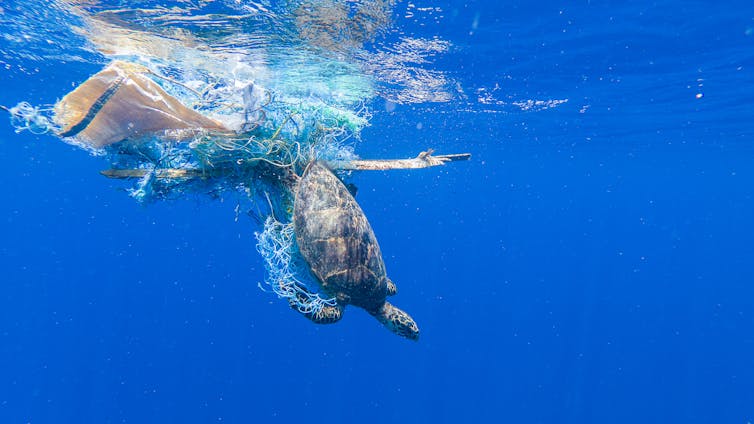 Discarded fishing nets, or ‘ghost nets’ can entangle animals like turtles.
Shutterstock
A scourge on small island nations
Plastic is extremely durable, and can float vast distances across the ocean. In 2011, 5 million tonnes of debris entered the Pacific during the Japan tsunami. Some crossed the entire ocean basin, ending up on North American coastlines.
And since floating plastics in the open ocean are transported mainly by ocean surface currents and winds, plastic debris accumulates on island coastlines along their path. Kamilo Beach, on the south-eastern tip of Hawaii’s Big Island, is considered one of the world’s worst for plastic pollution. Up to 20 tonnes of debris wash onto the beach each year.
Similarly, on uninhabited Henderson Island, part of the Pitcairn Island chain in the south Pacific, 18 tonnes of plastic have accumulated on a beach just 2.5km long. Several thousand pieces of plastic wash up each day.
Kamilo Beach is referred to as the world’s dirtiest.Subtropical garbage patches
Plastic waste can have different fates in the ocean: some sink, some wash up on beaches and some float on the ocean surface, transported by currents, wind and waves.
Around 1% of plastic waste accumulates in five subtropical “garbage patches” in the open ocean. They’re formed as a result of ocean circulation, driven by the changing wind fields and the Earth’s rotation.
There are two subtropical garbage patches in the Pacific: one in the northern and one in the southern hemisphere.
The northern accumulation region is separated into an eastern patch between California and Hawaii, and a western patch, which extends eastwards from Japan.
Discarded fishing nets, or ‘ghost nets’ can entangle animals like turtles.
Shutterstock
A scourge on small island nations
Plastic is extremely durable, and can float vast distances across the ocean. In 2011, 5 million tonnes of debris entered the Pacific during the Japan tsunami. Some crossed the entire ocean basin, ending up on North American coastlines.
And since floating plastics in the open ocean are transported mainly by ocean surface currents and winds, plastic debris accumulates on island coastlines along their path. Kamilo Beach, on the south-eastern tip of Hawaii’s Big Island, is considered one of the world’s worst for plastic pollution. Up to 20 tonnes of debris wash onto the beach each year.
Similarly, on uninhabited Henderson Island, part of the Pitcairn Island chain in the south Pacific, 18 tonnes of plastic have accumulated on a beach just 2.5km long. Several thousand pieces of plastic wash up each day.
Kamilo Beach is referred to as the world’s dirtiest.Subtropical garbage patches
Plastic waste can have different fates in the ocean: some sink, some wash up on beaches and some float on the ocean surface, transported by currents, wind and waves.
Around 1% of plastic waste accumulates in five subtropical “garbage patches” in the open ocean. They’re formed as a result of ocean circulation, driven by the changing wind fields and the Earth’s rotation.
There are two subtropical garbage patches in the Pacific: one in the northern and one in the southern hemisphere.
The northern accumulation region is separated into an eastern patch between California and Hawaii, and a western patch, which extends eastwards from Japan.
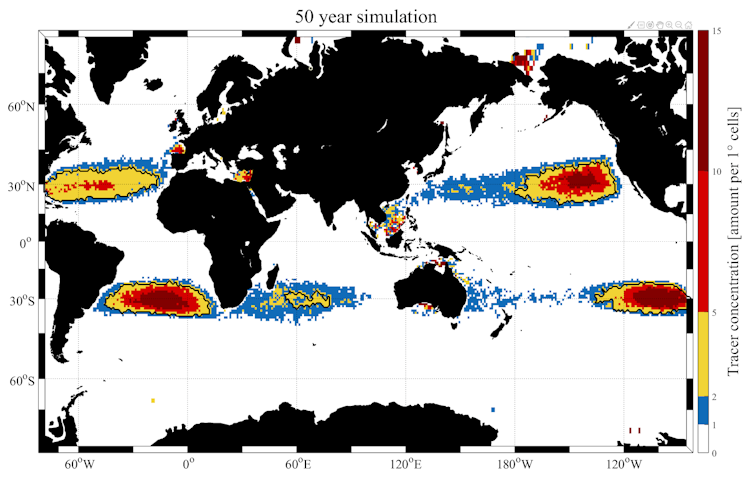 Locations of the five subtropical garbage patches.
van der Mheen et al. (2019)
Our ocean garbage shame
First discovered by Captain Charles Moore in the early 2000s, the eastern patch is better known as the Great Pacific Garbage Patch because it’s the largest by both size (around 1.6 million square kilometers) and amount of plastic. By weight, this garbage patch can hold more than 100 kilograms per square kilometre.
The garbage patch in the southern Pacific is located off Valparaiso, Chile, extending to the west. It has lower concentrations compared to its giant counterpart in the northeast.
Discarded fishing nets make up around 45% of the total plastic weight in the Great Pacific Garbage Patch. Waste from the 2011 Japan tsunami is also a major contributor, making up an estimated 20% of the patch.
Read more:
Whales and dolphins found in the Great Pacific Garbage Patch for the first time
With time, larger plastic debris degrades into microplastics. Microplastics form only 8% of the total weight of plastic waste in the Great Pacific Garbage Patch, but make up 94% of the estimated 1.8 trillion pieces of plastic there. In high concentrations, they can make the water “cloudy”.
Each year, up to 15 million tonnes of plastic waste are estimated to make their way into the ocean from coastlines and rivers. This amount is expected to double by 2025 as plastic production continues to increase.
We must act urgently to stem the flow. This includes developing plans to collect and remove the plastics and, vitally, stop producing so much in the first place.
Divers releasing a whale shark from a fishing net.Fisheries on the verge of collapse
As the largest and deepest sea on Earth, the Pacific supports some of the world’s biggest fisheries. For thousands of years, people have relied on these fisheries for their food and livelihoods.
But, around the world, including in the Pacific, fishing operations are depleting fish populations faster than they can recover. This overfishing is considered one of the most serious threats to the world’s oceans.
Humans take about 80 million tonnes of wildlife from the sea each year. In 2019, the world’s leading scientists said of all threats to marine biodiversity over the past 50 years, fishing has caused the most harm. They said 33% of fish species were overexploited, 60% were being fished to the maximum level, and just 7% were underfished.
The decline in fish populations is not just a problem for humans. Fish play an important role in marine ecosystems and are a crucial link in the ocean’s complex food webs.
Locations of the five subtropical garbage patches.
van der Mheen et al. (2019)
Our ocean garbage shame
First discovered by Captain Charles Moore in the early 2000s, the eastern patch is better known as the Great Pacific Garbage Patch because it’s the largest by both size (around 1.6 million square kilometers) and amount of plastic. By weight, this garbage patch can hold more than 100 kilograms per square kilometre.
The garbage patch in the southern Pacific is located off Valparaiso, Chile, extending to the west. It has lower concentrations compared to its giant counterpart in the northeast.
Discarded fishing nets make up around 45% of the total plastic weight in the Great Pacific Garbage Patch. Waste from the 2011 Japan tsunami is also a major contributor, making up an estimated 20% of the patch.
Read more:
Whales and dolphins found in the Great Pacific Garbage Patch for the first time
With time, larger plastic debris degrades into microplastics. Microplastics form only 8% of the total weight of plastic waste in the Great Pacific Garbage Patch, but make up 94% of the estimated 1.8 trillion pieces of plastic there. In high concentrations, they can make the water “cloudy”.
Each year, up to 15 million tonnes of plastic waste are estimated to make their way into the ocean from coastlines and rivers. This amount is expected to double by 2025 as plastic production continues to increase.
We must act urgently to stem the flow. This includes developing plans to collect and remove the plastics and, vitally, stop producing so much in the first place.
Divers releasing a whale shark from a fishing net.Fisheries on the verge of collapse
As the largest and deepest sea on Earth, the Pacific supports some of the world’s biggest fisheries. For thousands of years, people have relied on these fisheries for their food and livelihoods.
But, around the world, including in the Pacific, fishing operations are depleting fish populations faster than they can recover. This overfishing is considered one of the most serious threats to the world’s oceans.
Humans take about 80 million tonnes of wildlife from the sea each year. In 2019, the world’s leading scientists said of all threats to marine biodiversity over the past 50 years, fishing has caused the most harm. They said 33% of fish species were overexploited, 60% were being fished to the maximum level, and just 7% were underfished.
The decline in fish populations is not just a problem for humans. Fish play an important role in marine ecosystems and are a crucial link in the ocean’s complex food webs.
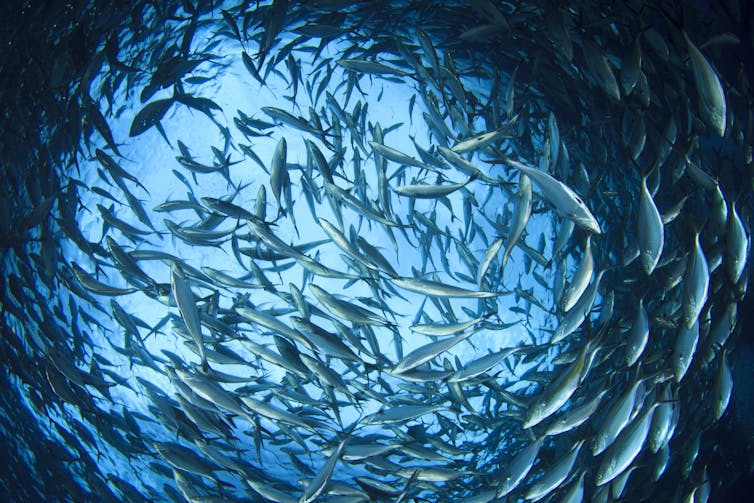 Overfishing is stripping the Pacific Ocean of marine life.
Shutterstock
Not plenty of fish in the sea
Overfishing happens when humans extract fish resources beyond the maximum level, known as the “maximum sustainable yield”. Fishing beyond this causes global fish stocks to decline, disrupts food chains, degrades habitats, and creates food scarcity for humans.
The Pacific Ocean is home to huge tuna fisheries, which provide almost 65% of the global tuna catch each year. But the long-term survival of many tuna populations is at risk.
For example, a study released in 2013 found numbers of bluefin tuna – a prized fish used to make sushi – had declined by more than 96% in the Northern Pacific Ocean.
Developing countries, including Indonesia and China, are major overfishers, but so too are developing nations.
Read more:
When hurricanes temporarily halt fishing, marine food webs recover quickly
Along Canada’s west coast, Pacific salmon populations have declined rapidly since the early 1990s, partly due to overfishing. And Japan was recently heavily criticised for a proposal to increase quotas on Pacific bluefin tuna, a species reportedly at just 4.5% of its historic population size.
Experts say overfishing is also a problem in Australia. For example, research in 2018 showed large fish species were rapidly declining around the nation due to excessive fishing pressure. In areas open to fishing, exploited populations fell by an average of 33% in the decade to 2015.
Overfishing is stripping the Pacific Ocean of marine life.
Shutterstock
Not plenty of fish in the sea
Overfishing happens when humans extract fish resources beyond the maximum level, known as the “maximum sustainable yield”. Fishing beyond this causes global fish stocks to decline, disrupts food chains, degrades habitats, and creates food scarcity for humans.
The Pacific Ocean is home to huge tuna fisheries, which provide almost 65% of the global tuna catch each year. But the long-term survival of many tuna populations is at risk.
For example, a study released in 2013 found numbers of bluefin tuna – a prized fish used to make sushi – had declined by more than 96% in the Northern Pacific Ocean.
Developing countries, including Indonesia and China, are major overfishers, but so too are developing nations.
Read more:
When hurricanes temporarily halt fishing, marine food webs recover quickly
Along Canada’s west coast, Pacific salmon populations have declined rapidly since the early 1990s, partly due to overfishing. And Japan was recently heavily criticised for a proposal to increase quotas on Pacific bluefin tuna, a species reportedly at just 4.5% of its historic population size.
Experts say overfishing is also a problem in Australia. For example, research in 2018 showed large fish species were rapidly declining around the nation due to excessive fishing pressure. In areas open to fishing, exploited populations fell by an average of 33% in the decade to 2015.
 Stocks of fish used to make sushi have declined in number.
Shutterstock
So what’s driving overfishing?
There are many reasons why overfishing occurs and why it is goes unchecked. The evidence points to:
Read more:
The race to fish: how fishing subsidies are emptying our oceans
Let’s take Indonesia as an example. Indonesia lies between the Pacific and Indian oceans and is the world’s third-biggest producer of wild-capture fish after China and Peru. Some 60% of the catch is made by small-scale fishers. Many hail from poor coastal communities.
Overfishing was first reported in Indonesia in the 1970s. It prompted a presidential decree in 1980, banning trawling off the islands of Java and Sumatra. But overfishing continued into the 1990s, and it persists today. Target species include reef fishes, lobster, prawn, crab, and squid.
Indonesia’s experience shows how there is no easy fix to the overfishing problem. In 2017, the Indonesian government issued a decree that was supposed to keep fishing to a sustainable level – 12.5 million tonnes per year. Yet, in may places, the practice continued – largely because the rules were not clear and local enforcement was inadequate.
Implementation was complicated by the fact that almost all Indonesia’s smaller fishing boats come under the control of provincial governments. This reveals the need for better cooperation between levels of government in cracking down on overfishing.
Stocks of fish used to make sushi have declined in number.
Shutterstock
So what’s driving overfishing?
There are many reasons why overfishing occurs and why it is goes unchecked. The evidence points to:
Read more:
The race to fish: how fishing subsidies are emptying our oceans
Let’s take Indonesia as an example. Indonesia lies between the Pacific and Indian oceans and is the world’s third-biggest producer of wild-capture fish after China and Peru. Some 60% of the catch is made by small-scale fishers. Many hail from poor coastal communities.
Overfishing was first reported in Indonesia in the 1970s. It prompted a presidential decree in 1980, banning trawling off the islands of Java and Sumatra. But overfishing continued into the 1990s, and it persists today. Target species include reef fishes, lobster, prawn, crab, and squid.
Indonesia’s experience shows how there is no easy fix to the overfishing problem. In 2017, the Indonesian government issued a decree that was supposed to keep fishing to a sustainable level – 12.5 million tonnes per year. Yet, in may places, the practice continued – largely because the rules were not clear and local enforcement was inadequate.
Implementation was complicated by the fact that almost all Indonesia’s smaller fishing boats come under the control of provincial governments. This reveals the need for better cooperation between levels of government in cracking down on overfishing.
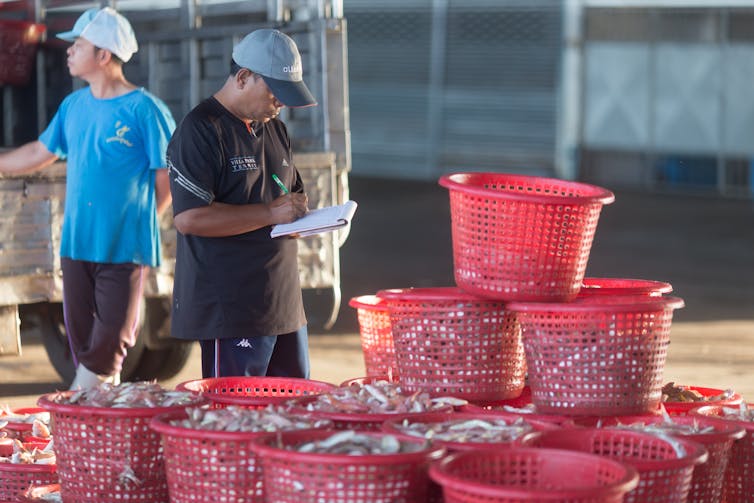 Globally, compliance and enforcement of fishing limits is often poor.
Shutterstock
What else can we do?
To prevent overfishing, governments should address the issue of poverty and poor education in small fishing communities. This may involve finding them a new source of income. For example in the town of Oslob in the Philippines, former fishermen and women have turned to tourism – feeding whale sharks tiny amounts of krill to draw them closer to shore so tourists can snorkel or dive with them.
Tackling overfishing in the Pacific will also require cooperation among nations to monitor fishing practices and enforce the rules.
And the world’s network of marine protected areas should be expanded and strengthened to conserve marine life. Currently, less than 3% of the world’s oceans are highly protected “no take” zones. In Australia, many marine reserves are small and located in areas of little value to commercial fishers.
The collapse of fisheries around the world shows just how vulnerable our marine life is. It’s clear that humans are exploiting the oceans beyond sustainable levels. Billions of people rely on seafood for protein and for their livelihoods. But by allowing overfishing to continue, we harm not just the oceans, but ourselves.
Globally, compliance and enforcement of fishing limits is often poor.
Shutterstock
What else can we do?
To prevent overfishing, governments should address the issue of poverty and poor education in small fishing communities. This may involve finding them a new source of income. For example in the town of Oslob in the Philippines, former fishermen and women have turned to tourism – feeding whale sharks tiny amounts of krill to draw them closer to shore so tourists can snorkel or dive with them.
Tackling overfishing in the Pacific will also require cooperation among nations to monitor fishing practices and enforce the rules.
And the world’s network of marine protected areas should be expanded and strengthened to conserve marine life. Currently, less than 3% of the world’s oceans are highly protected “no take” zones. In Australia, many marine reserves are small and located in areas of little value to commercial fishers.
The collapse of fisheries around the world shows just how vulnerable our marine life is. It’s clear that humans are exploiting the oceans beyond sustainable levels. Billions of people rely on seafood for protein and for their livelihoods. But by allowing overfishing to continue, we harm not just the oceans, but ourselves.
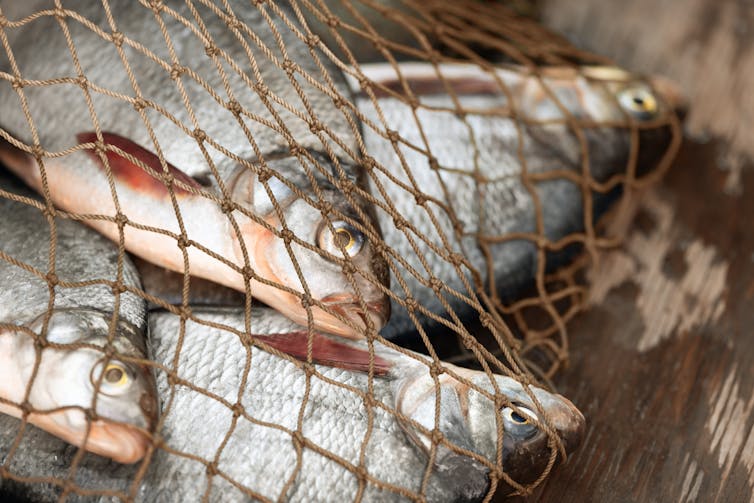 Providing fishers with an alternative income can help prevent overfishing.
Shutterstock
Read more:
Poor Filipino fishermen are making millions protecting whale sharks
The threat of acidic oceans
The tropical and subtropical waters of the Pacific Ocean are home to more than 75% of the world’s coral reefs. These include the Great Barrier Reef and more remote reefs in the Coral Triangle, such as those in Indonesia and Papua New Guinea.
Coral reefs are bearing the brunt of climate change. We hear a lot about how coral bleaching is damaging coral ecosystems. But another insidious process, ocean acidification, is also threatening reef survival.
Ocean acidification particularly affects shallow waters, and the subarctic Pacific region is particularly vulnerable.
Coral reefs cover less than 0.5% of Earth’s surface, but house an estimated 25% of all marine species. Due to ocean acidification and other threats, these incredibly diverse “underwater rainforests” are among the most threatened ecosystems on the planet.
Providing fishers with an alternative income can help prevent overfishing.
Shutterstock
Read more:
Poor Filipino fishermen are making millions protecting whale sharks
The threat of acidic oceans
The tropical and subtropical waters of the Pacific Ocean are home to more than 75% of the world’s coral reefs. These include the Great Barrier Reef and more remote reefs in the Coral Triangle, such as those in Indonesia and Papua New Guinea.
Coral reefs are bearing the brunt of climate change. We hear a lot about how coral bleaching is damaging coral ecosystems. But another insidious process, ocean acidification, is also threatening reef survival.
Ocean acidification particularly affects shallow waters, and the subarctic Pacific region is particularly vulnerable.
Coral reefs cover less than 0.5% of Earth’s surface, but house an estimated 25% of all marine species. Due to ocean acidification and other threats, these incredibly diverse “underwater rainforests” are among the most threatened ecosystems on the planet.
 The Pacific is home to morfe than 75% of the world’s coral reefs.
Victor Huertas, Author provided (No reuse)
A chemical reaction
Ocean acidification involves a decrease in the pH of seawater as it absorbs carbon dioxide (CO₂) from the atmosphere.
Each year, humans emit 35 billion tonnes of CO₂ through activities such as burning of fossil fuels and deforestation.
Oceans absorb up to 30% of atmospheric CO₂, setting off a chemical reaction in which concentrations of carbonate ions fall, and hydrogen ion concentrations increase. That change makes the seawater more acidic.
Since the Industrial Revolution, ocean pH has decreased by 0.1 units. This may not seem like much, but it actually means the oceans are now about 28% more acidic than since the mid-1800s. And the Intergovernmental Panel on Climate Change (IPCC) says the rate of acidification is accelerating.
The Pacific is home to morfe than 75% of the world’s coral reefs.
Victor Huertas, Author provided (No reuse)
A chemical reaction
Ocean acidification involves a decrease in the pH of seawater as it absorbs carbon dioxide (CO₂) from the atmosphere.
Each year, humans emit 35 billion tonnes of CO₂ through activities such as burning of fossil fuels and deforestation.
Oceans absorb up to 30% of atmospheric CO₂, setting off a chemical reaction in which concentrations of carbonate ions fall, and hydrogen ion concentrations increase. That change makes the seawater more acidic.
Since the Industrial Revolution, ocean pH has decreased by 0.1 units. This may not seem like much, but it actually means the oceans are now about 28% more acidic than since the mid-1800s. And the Intergovernmental Panel on Climate Change (IPCC) says the rate of acidification is accelerating.
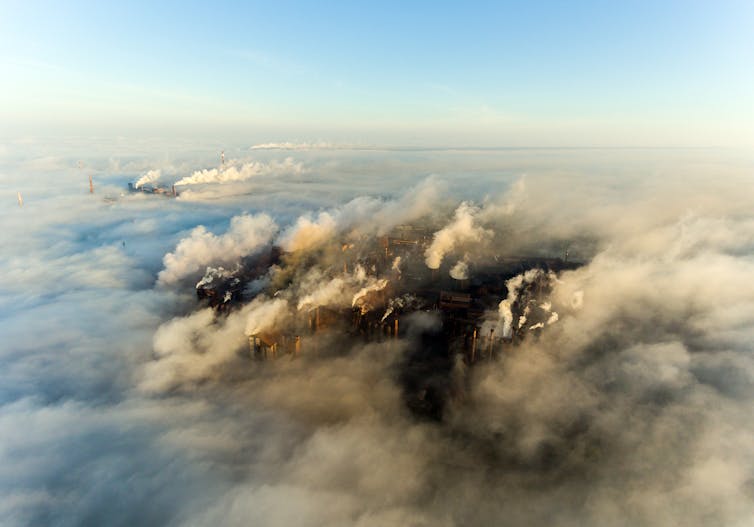 Each year, humans emit 35 billion tonnes of CO₂.
Shutterstock
Why is ocean acidification harmful?
Carbonate ions are the building blocks for coral structures and organisms that build shells. So a fall in the concentrations of carbonate ions can spell bad news for marine life.
In more acidic waters, molluscs have been shown to have trouble making and repairing their shells. They also exhibit impaired growth, metabolism, reproduction, immune function, and altered behaviours. For example, researchers exposed sea hares (a type of sea slug) in French Polynesia to simulated ocean acidification and found they had less foraging success and made poorer decisions.
Ocean acidification is also a problem for the fishes. Many studies have revealed elevated CO₂ can disrupt their sense of smell, vision and hearing. It can also impair survival traits, such as a fish’s ability to learn, avoid predators, and select suitable habitat.
Such impairment appears to be the result of changes in neurological, physiological, and molecular functions in fish brains.
Each year, humans emit 35 billion tonnes of CO₂.
Shutterstock
Why is ocean acidification harmful?
Carbonate ions are the building blocks for coral structures and organisms that build shells. So a fall in the concentrations of carbonate ions can spell bad news for marine life.
In more acidic waters, molluscs have been shown to have trouble making and repairing their shells. They also exhibit impaired growth, metabolism, reproduction, immune function, and altered behaviours. For example, researchers exposed sea hares (a type of sea slug) in French Polynesia to simulated ocean acidification and found they had less foraging success and made poorer decisions.
Ocean acidification is also a problem for the fishes. Many studies have revealed elevated CO₂ can disrupt their sense of smell, vision and hearing. It can also impair survival traits, such as a fish’s ability to learn, avoid predators, and select suitable habitat.
Such impairment appears to be the result of changes in neurological, physiological, and molecular functions in fish brains.
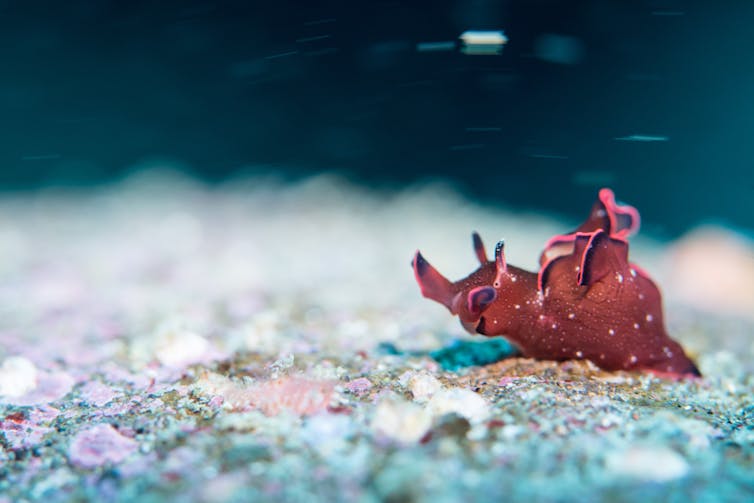 Sea hares exposed to acidification made poorer decisions.
Shutterstock
Predicting the winners and losers
Of the seven oceans, the Pacific and Indian Oceans have been acidifying at the fastest rates since 1991. This suggests their marine life may also be more vulnerable.
However, ocean acidification does not affect all marine species in the same way, and the effects can vary over the organism’s lifetime. So, more research to predict the future winners and losers is crucial.
This can be done by identifying inherited traits that can increase an organism’s survival and reproductive success under more acidic conditions. Winner populations may start to adapt, while loser populations should be targets for conservation and management.
Read more:
Acid oceans are shrinking plankton, fuelling faster climate change
One such winner may be the epaulette shark, a shallow water reef species endemic to the Great Barrier Reef. Research suggests simulated ocean acidification conditions do not impact early growth, development, and survival of embryos and neonates, nor do they affect foraging behaviours or metabolic performance of adults.
But ocean acidification is also likely to create losers on the Great Barrier Reef. For example, researchers studying the orange clownfish – a species made famous by Disney’s animated Nemo character – found they suffered multiple sensory impairments under simulated ocean acidification conditions. These ranged from difficulties smelling and hearing their way home, to distinguishing friend from foe.
Sea hares exposed to acidification made poorer decisions.
Shutterstock
Predicting the winners and losers
Of the seven oceans, the Pacific and Indian Oceans have been acidifying at the fastest rates since 1991. This suggests their marine life may also be more vulnerable.
However, ocean acidification does not affect all marine species in the same way, and the effects can vary over the organism’s lifetime. So, more research to predict the future winners and losers is crucial.
This can be done by identifying inherited traits that can increase an organism’s survival and reproductive success under more acidic conditions. Winner populations may start to adapt, while loser populations should be targets for conservation and management.
Read more:
Acid oceans are shrinking plankton, fuelling faster climate change
One such winner may be the epaulette shark, a shallow water reef species endemic to the Great Barrier Reef. Research suggests simulated ocean acidification conditions do not impact early growth, development, and survival of embryos and neonates, nor do they affect foraging behaviours or metabolic performance of adults.
But ocean acidification is also likely to create losers on the Great Barrier Reef. For example, researchers studying the orange clownfish – a species made famous by Disney’s animated Nemo character – found they suffered multiple sensory impairments under simulated ocean acidification conditions. These ranged from difficulties smelling and hearing their way home, to distinguishing friend from foe.
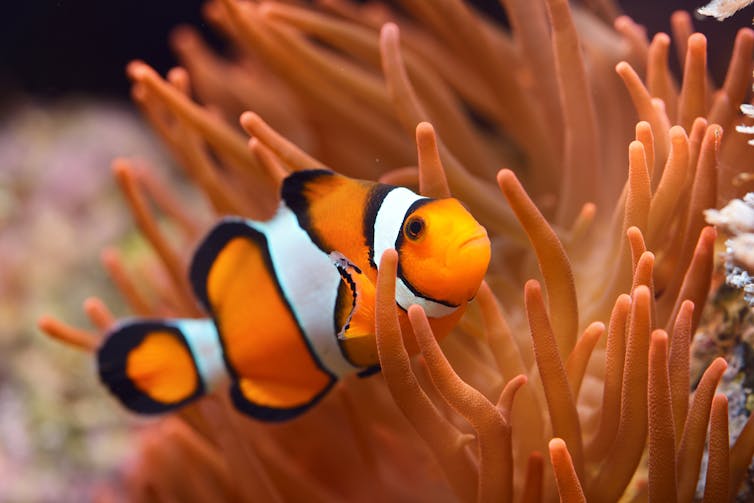 Clownfish struggled to tell friend from foe when exposed to ocean acidification.
Shutterstock
It’s not too late
More than half a billion people depend on coral reefs for food, income, and protection from storms and coastal erosion. Reefs provide jobs – such as in tourism and fishing – and places for recreation. Globally, coral reefs represent an industry worth US$11.9 trillion per year. And importantly, they’re a place of deep cultural and spiritual connection for Indigenous people around the world.
Ocean acidification is not the only threat to coral reefs. Under climate change, the rate of ocean warming has doubled since the 1990s. The Great Barrier Reef, for example, has warmed by 0.8℃ since the Industrial Revolution. Over the past five years this has caused devastating back-to-back coral bleaching events. The effects of warmer seas are magnified by ocean acidification.
Read more:
Coronavirus is a 'sliding doors' moment. What we do now could change Earth's trajectory
Cutting greenhouse gas emissions must become a global mission. COVID-19 has slowed our movements across the planet, showing it’s possible to radically slash our production of CO₂. If the world meets the most ambitious goals of the Paris Agreement and keeps global temperature increases below 1.5℃, the Pacific will experience far less severe decreases in oceanic pH.
We will, however, have to curb emissions by a lot more – 45% over the next decade – to keep global warming below 1.5℃. This would give some hope that coral reefs in the Pacific, and worldwide, are not completely lost.
Clearly, the decisions we make today will affect what our oceans look like tomorrow.
Clownfish struggled to tell friend from foe when exposed to ocean acidification.
Shutterstock
It’s not too late
More than half a billion people depend on coral reefs for food, income, and protection from storms and coastal erosion. Reefs provide jobs – such as in tourism and fishing – and places for recreation. Globally, coral reefs represent an industry worth US$11.9 trillion per year. And importantly, they’re a place of deep cultural and spiritual connection for Indigenous people around the world.
Ocean acidification is not the only threat to coral reefs. Under climate change, the rate of ocean warming has doubled since the 1990s. The Great Barrier Reef, for example, has warmed by 0.8℃ since the Industrial Revolution. Over the past five years this has caused devastating back-to-back coral bleaching events. The effects of warmer seas are magnified by ocean acidification.
Read more:
Coronavirus is a 'sliding doors' moment. What we do now could change Earth's trajectory
Cutting greenhouse gas emissions must become a global mission. COVID-19 has slowed our movements across the planet, showing it’s possible to radically slash our production of CO₂. If the world meets the most ambitious goals of the Paris Agreement and keeps global temperature increases below 1.5℃, the Pacific will experience far less severe decreases in oceanic pH.
We will, however, have to curb emissions by a lot more – 45% over the next decade – to keep global warming below 1.5℃. This would give some hope that coral reefs in the Pacific, and worldwide, are not completely lost.
Clearly, the decisions we make today will affect what our oceans look like tomorrow.
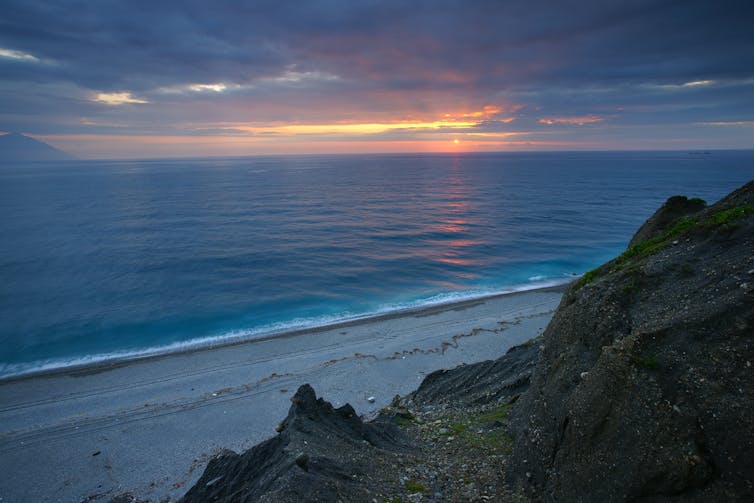 Our decisions today will determine the fate of tomorrow’s oceans.
Shutterstock
Our decisions today will determine the fate of tomorrow’s oceans.
Shutterstock
Authors: Jodie L. Rummer, Associate Professor & Principal Research Fellow, James Cook University



